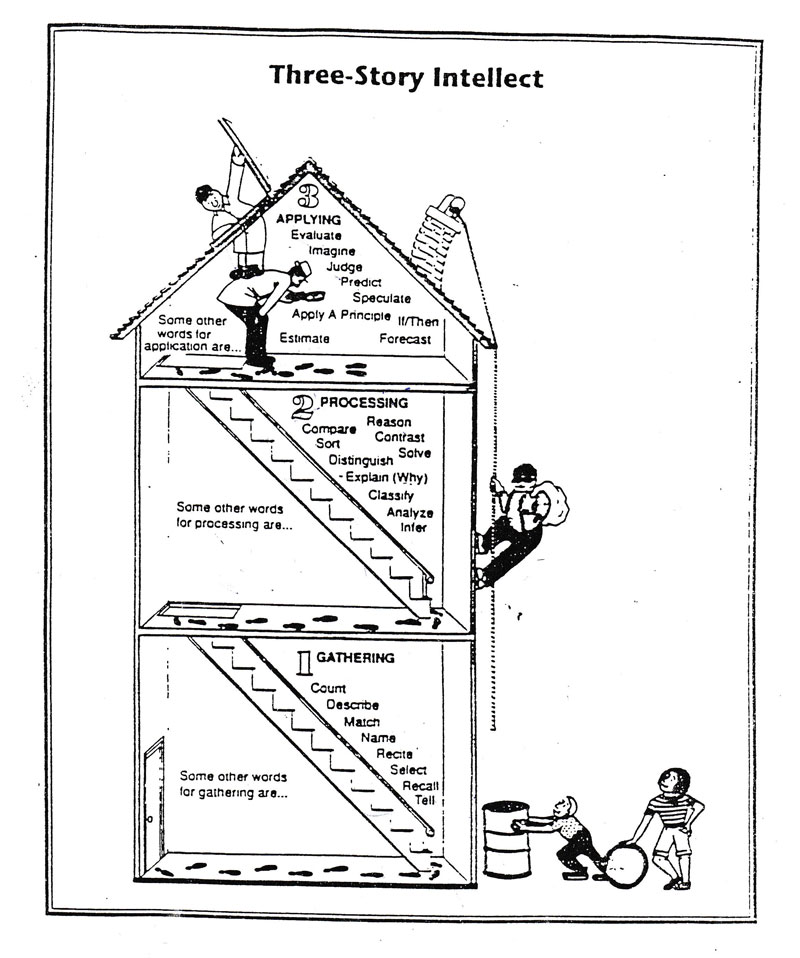Day 7
Context
Today we take a little break for looking at specific observable phenomena and think about learning in general and how it applys to this class.
Explanation
| Video Links |
Video Popup
|
Class Video
|
We will look at two constructs of how people learn and try to apply them to this class.
After this class you should be able to:
- Describe the general process of how people learn something new.
- Have a better understanding of why we do some of the crazy things we do in this class.
Model
Three-Story Intellect
The first model we will discuss is called the "Three-Story Intellect." This model is a picture of a 3-story house. It associates different activities with each level of the house. On the ground level there is gathering. On the second floor there is processing. On the third floor there is applying. Since the graphic may be hard to read I will copy the words starting at the bottom and working upward (opposite from the picture).
- Gathering
- Count
- Describe
- Match
- Name
- Recite
- Select
- Recall
- Tell
- Processing
- Compare
- Sort
- Distingush
- Explain (Why)
- Classify
- Analyze
- Infer
- Reason
- Contrast
- Solve
- Applying
- Evaluate
- Imagine
- Judge
- Predict
- Speculate
- Estimate
- Forecast
- If/then
What is this model trying to say? Does it relate to anything you have studied in the past? What changes as you go from level to level?
Here are two quesions to consider: How would you teach a course staying at the bottom level for the whole course? At what level should this course be taught at?
3-Phase Inquiry Learning Cycle
The learning cycle provides a way to think about how we go about investigating our world.
Three-Phase Inquiry Learning Cycle
Inquiry Cycle Science Classroom Exploration Open Inquiry
Student Exploration of phenomenon
- Student engages with the phenomenon
- Student determines a question for focused exploration
Experimentation
and
Data CollectionStudent Developed Inquiry
Sense-Making Conceptual Inquiry
Modified from Making Science Mentors by Bernie Zubrowski, Vivian Troen, and Marian Pasquale (NSTA Press, 2007) by Fiona McDonnell and David Burgess.
Notice how the learning is all student-developed. The idea is to have students make self-directed explorations and observations of natural phenomena. They explore and develop their own authentic questions. They devise ways of gathering, organizing and displaying data. And they make sense of the data and communicate it to others, creating a community of science learners in the classroom.
Phases of our 3-Phase Inquiry Learning Cycle
- The first phase is exploration. The student engages with the phenomenon which generates questions. The student then determines a question for focused exploration.
- In phase two the student designs an experiment and gathers data about the question they have chosen.
- In phase three the student analyzes their data to make a finding. The student organizes/displays the data as a tool to illuminate the question and then communicates their investigation and findings.
At the same time that the student is undergoing their investigation, the teacher is also doing research and undergoing an inquiry cycle. Here is a chart that summarizes both the student and the teacher inquiry.
The inquiry leaning cycle is best implemented in a classroom where you can actually manipulate physical objects and come up with your own ideas and questions. I have tried to model it in some of our activities, but it is much harder in this online environment. Hopefully you can get a sense of what this is about and maybe try to do more of it in your own classrooms.
Here is a link to more detail about our Inquiry Learning Style.
Homework
The homework for this class is on Canvas.
